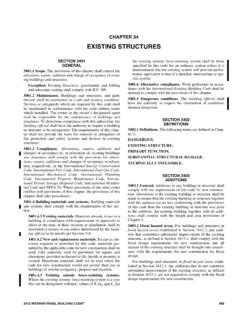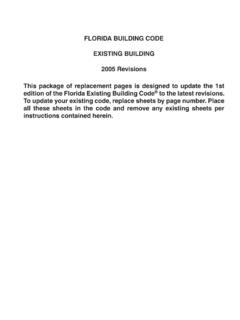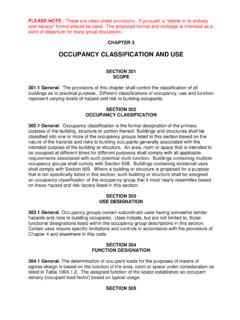Transcription of Electric Vehicles and Building Codes: A Strategy for ...
1 Vehicles and Building Codes: A Strategy for Greenhouse Gas | page 2 Electric Vehicles AND Building CODESCONFIDENTIALINTRODUCTIONIn 2019, the transportation sector accounted for 29 percent of the nation s greenhouse gas (GHG) emissions, with the demand for travel consistently increasing from 1990 to The Federal Government has adopted decarbonization policies to reduce emissions, support green job growth, improve equity, and mitigate the impacts of climate change. A major initiative of the Federal Government has been to reduce carbon pollution from the transportation sector.
2 The adoption of Electric Vehicles (EVs) and implementation of EV infrastructure through Building codes supports the national goal of achieving net-zero GHG emissions by 2050, which in turn supports the climate initiative of limiting global warming to degrees In August of this year, the administration released an Executive Order encouraging one-half of all new Vehicles sold in 2030 to be zero-emissions Vehicles , including battery Electric , plug-in hybrid Electric or fuel cell Electric American automakers including Ford, General Motors and Stellantis, and the United Auto Workers.
3 Are aligning their EV targets in support of this goal. The built environment will need to facilitate charging infrastructure that supports the increasing deployment of all classes (light-duty, medium-duty and heavy-duty) of EVs across the nation to meet GHG reduction targets. Buildings and Building codes have been identified as important components in comprehensive, community-wide strategies to advance the deployment of EV charging infrastructure. EV infrastructure requirements in Building codes support the transition towards EV ownership by increasing access to parking spaces with charging stations.
4 Current EV charging provisions in some state and local Building codes typically require new buildings and major renovations to include a mixture of parking spaces with installed EV charging infrastructure and some with the necessary electrical equipment to support the future installation of EV charging equipment as EV use continues to grow. Published studies show that the installation of EV electrical equipment into new buildings can decrease installation costs of charging stations by up to 75 percent compared to installation during a Building ABOUT THIS DOCUMENTIn March 2021, the International Code Council s (Code Council s) Board of Directors issued a new framework to support advancements in energy efficiency and GHG reductions, Leading the Way to Energy Efficiency: A Path Forward on Energy and Sustainability to Confront a Changing Climate.
5 The framework includes provisions for the development of technical and policy resources that provide communities with tools to support achievement of their energy efficiency and GHG reduction goals. The resources are intended to be useable independently and adopted alongside the baseline code to support community needs in specific areas. This document presents the solutions select jurisdictions have enacted to support increased EV deployment. Also included is model language that communities can use to set their own policies. The model language is designed to provide communities with approaches that reflect local conditions and needs.
6 This language follows a format that can be directly integrated into the International Codes (I-Codes ) including the International Energy Conservation Code (IECC ), International Building Code (IBC ) and the International Residential Code (IRC ) and was compiled by the Code Council with input from interested stakeholders, as identified in the document spells out placement of EV charging requirements within the IRC and IECC. The new scope and intent for the IECC moving forward (as defined by the Code Council Board of Directors) includes avenues for the inclusion of energy and GHG reduction requirements like EV charging.
7 EV charging requirements could also be located in the IBC with the current EV requirements in Section 406. In July 2021, The Department of Energy (DOE) and the Pacific Northwest National Laboratory (PNNL) developed a technical brief, Electric Vehicle Charging for Residential and Commercial Energy Codes with input from the Code Council. The language presented throughout the Code Council s resource is largely consistent with DOE and PNNL s technical brief, but provides flexibility for local jurisdictions on the number and type of EV spaces and reflects additional feedback received from a diverse set of stakeholders, listed within the resource s appendix.
8 1. Environmental protection Agency, Sources of Greenhouse Gas Emissions, (2021).2. The White House, Fact Sheet: President Biden Sets 2030 Greenhouse Gas Pollution Reduction , (2021).3. The White House, Executive Order on Strengthening American Leadership in Clean Cars and Trucks, (2021).4. Southwest Energy Efficiency Project, EV Infrastructure Building Codes: Adoption Toolkit, (2020) | page 3 Electric Vehicles AND Building CODESCONFIDENTIALEV-related policy is evolving. This resource captures the prevailing strategies communities have already deployed. As strategies change, the Code Council will review this content to assure its continued relevance.
9 Additionally, the content may be considered as the basis for EV-related criteria in future editions of the I-Codes which will allow for further EV-INTEGRATED Building CODE STRATEGIEST here are three EV parking space charging infrastructure strategies that Building codes can include for new buildings: EV-Capable, EV-Ready and EVSE-Installed. EV-Capable: Parking spaces that have the electrical panel capacity and conduit installed during construction to support future implementation of EV charging with 208/240-volt (or greater), 40-ampere (or greater) circuits. This Strategy ensures the reduction of up-front costs for EV charging station installation by providing the electrical elements that are difficult to install during a retrofit.
10 Anticipating the use of dual head EVSE, the same circuit may be used to support charging in adjacent EV-Capable spaces. EV-Ready: Parking spaces that have full circuit installations of 208/240-volt (or greater), 40-ampere (or greater) panel capacity, raceway wiring, receptacle and circuit overprotection devices. This Strategy provides all required electrical hardware for the future installation of EV Supply Equipment (EVSE). Anticipating the use of dual head EVSE, the same circuit may be used to support charging in adjacent EV-Ready : EV Supply Equipment (EVSE) that is fully installed from the electrical panel to the parking space.













